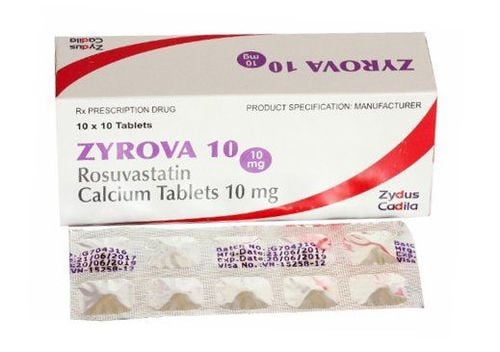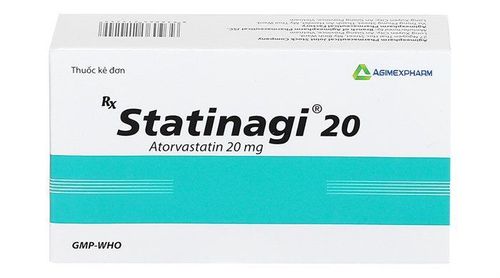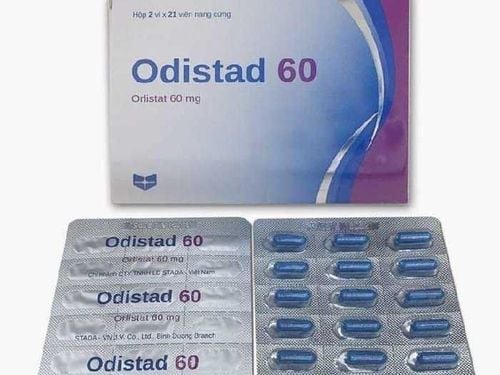This is an automatically translated article.
Fibrofin 145 drug is often prescribed by doctors in cases of hypercholesterolemia, endogenous hypertriglyceridemia after applying a diet but it is not effective. Let's find out the necessary information about the use of Fibrofin 145 through the article below.
1. What is Fibrofin 145?
Fibrofin-145 drug, or Fibrofin 145 film-coated tablet manufactured by Hetero Labs Limited (India) is effective in the treatment of primary hypercholesterolemia or mixed dyslipidemia and severe hypertriglyceridemia, With ingredients in the drug, it helps to improve the status of fatty blood and stabilize the health status of patients. The drug has the main ingredient is Fenofibrate 145mg, in the form of film-coated tablets.
2. What are the effects of Fibrofin 145?
Fibrofin 145 is used to treat:
Primary hypercholesterolemia or mixed dyslipidemia: Fenofibrate is indicated as adjunct to diet to reduce elevated lipoprotein cholesterol (LDL-C). low-density lipoprotein cholesterol, total cholesterol (Total-C), triglycerides and apolipoprotein B (Apo B), and elevated high-density lipoprotein cholesterol (HDL-C) in adult patients with primary hypercholesterolemia or mixed dyslipidemia.
Severe Hypertriglyceridemia: Fenofibrate is indicated as an adjunct to diet for the treatment of adult patients with severe hypertriglyceridemia. Improved glycemic control in patients with diabetes suggests that fasting chyme microbiota often precludes the need for pharmacological intervention. Significant elevations of serum triglycerides (eg, > 2,000 mg/dL) may increase the risk of developing pancreatitis. The effects of fenofibrate therapy on reducing this risk have not been adequately studied.
Important Limits of Use: Fenofibrate at doses equivalent to 145 mg fenofibrate has not been shown to reduce coronary artery disease and mortality in a randomized controlled trial of patients with diabetes. remove type 2 line.
3. Usage of Fibrofin 145
3.1. Dosage of Fibrofin 145 Patients need to follow an appropriate lipid-lowering diet prior to using fenofibrate, and the diet should be continued during treatment with fenofibrate. Use of Fenofibrate is not related to meals.
3.2. Dosage of Fibrofin 145 Primary Hypercholesterolemia or Mixed Dyslipidemia: The initial dose of Fenofibrate is 145mg once daily. Severe hypertriglyceridemia: The starting dose is 48mg to 145mg/day. The dose is individual and patient response and should be adjusted if deemed necessary after lipid determinations periodically approximately every 4 to 8 weeks. The maximum dose is 145mg once a day. Impaired Renal Function: Treatment with fenofibrate tablets should be initiated at a dose of 48 mg/day in patients with mild to moderate renal impairment, and the dose should be increased after assessing the effect on renal function and level. lipids at this dose. Fenofibrate should be avoided in patients with severe renal impairment. Elderly patients: Dose selection in the elderly should be based on baseline renal function. 3.3. Management of Overdose and Missed Dose Treatment for Missed Dose Take the dose as soon as you remember it. If it is almost time for the next dose, skip the missed dose and take the next dose only. Do not take a double dose.
Treatment of overdose If an overdose occurs, it is necessary to notify the doctor immediately, or if you see unusual symptoms, you need to go to the hospital for timely treatment.
4. Contraindications of Fibrofin 145
Patients with severe renal impairment will include patients on hemodialysis. Patients with liver disease include patients with primary biliary cirrhosis and unexplained persistent abnormal liver function. Patients with pre-existing gallbladder disease. Patients also have a history of hypersensitivity to fenofibrate or fenofibric acid. Women who are breastfeeding. Children under 10 years old.
5. Notes when using Fibrofin 145
Mortality and coronary artery disease: The effect of fenofibrate on morbidity and mortality of coronary artery disease and mortality of non-cardiovascular diseases has not been established. Skeletal muscle: Fibrates increase the risk of cardiomyopathy and have been associated with paroxysmal globinuria. The risk of developing serious myotoxicity is increased in elderly patients and in patients with diabetes, renal impairment or hypothyroidism. Hepatic function: Fenofibrate in doses equivalent to 96 mg to 145 mg of fenofibrate/day was associated with increases in serum transaminases [AST (SGOT) or ALT (SGPT)]. Serum Creatinine: Increased serum creatinine in patients receiving fenofibrate. Renal function should be monitored in patients with renal impairment receiving fenofibrate. Renal function should also be monitored in fenofibrate-treated patients at risk of renal impairment, such as elderly patients and patients with diabetes mellitus. Gallstones: Fenofibrate, like clofibrat and gemfibrozil, may increase the excretion of cholesterol in the gallbladder leading to gallstones. If gallstones are found, fenofibrate therapy should be discontinued. Coumarin Anticoagulants: Coumarin anticoagulants should be used with caution in combination with fenofibrate due to the potential for coumarin anticoagulant effects to prolong prothrombin time/international normalized ratio (PT/INR). . Pancreatitis: Pancreatitis has been reported in patients receiving fenofibrate, gemfibrozil, and clofibrate. If this occurs, it means that the drug is not effective in patients with severe hypertriglyceridemia due to a direct effect of the drug or a secondary effect of the drug through gallstones or sludge formation. gallbladder. Hematological Changes: Hemoglobin, hematocrit, and white blood cell counts were mild to moderate in patients initiating fenofibrate therapy. Periodic monitoring of red and white blood cells is recommended during the first 12 months of fenofibrate use. Hypersensitivity reactions: Stevens-Johnson syndrome and toxic epidermal necrolysis have been observed requiring hospitalization and steroid therapy in patients treated with fenofibrate. Thromboembolic disease: The incidence of pulmonary embolism (PE) and deep vein thrombosis (DVT) was higher in patients receiving fenofibrate compared with the placebo group. Pregnancy and breast-feeding: Safety in pregnant women has not been established. There are no adequate studies with fenofibrate in pregnant women. If fenofibrate should be used during pregnancy only if the potential benefits outweigh the potential risks to the fetus. Breastfeeding women should not use fenofibrate. A decision should be made whether to discontinue breastfeeding or discontinue the drug taking into account the importance of the drug to the mother. Effects on ability to drive and use machines: Based on the properties of the drug, fenofibrate does not affect the ability to drive or use machines.
6. Side effects of the drug Fibrofin 145
The most common adverse effects are diarrhea, muscle cramps (cramps), fatigue, vomiting and nausea. Insomnia, abdominal pain, back pain, headache, abnormal liver function tests, increased ALT, increased CPK, increased AST, respiratory disorders, rhinitis have also been reported.
The following undesirable effects were detected after the use of fenofibrate was approved: myalgia, paroxysmal globinuria, pancreatitis, acute renal failure, muscle spasms, cirrhosis, hepatitis, deficiency blood, arthralgia, erythropoiesis, leukopenia, leukopenia and neurasthenia. Because the above reactions are reported voluntarily, from populations of indeterminate size, it is not possible to accurately predict the frequency of occurrence or determine a correlation with drug expression.
7. How to store Fibrofin 145
Store the medicine at a temperature below 30°C, away from moisture. To medicines out of reach of children.
Please dial HOTLINE for more information or register for an appointment HERE. Download MyVinmec app to make appointments faster and to manage your bookings easily.













